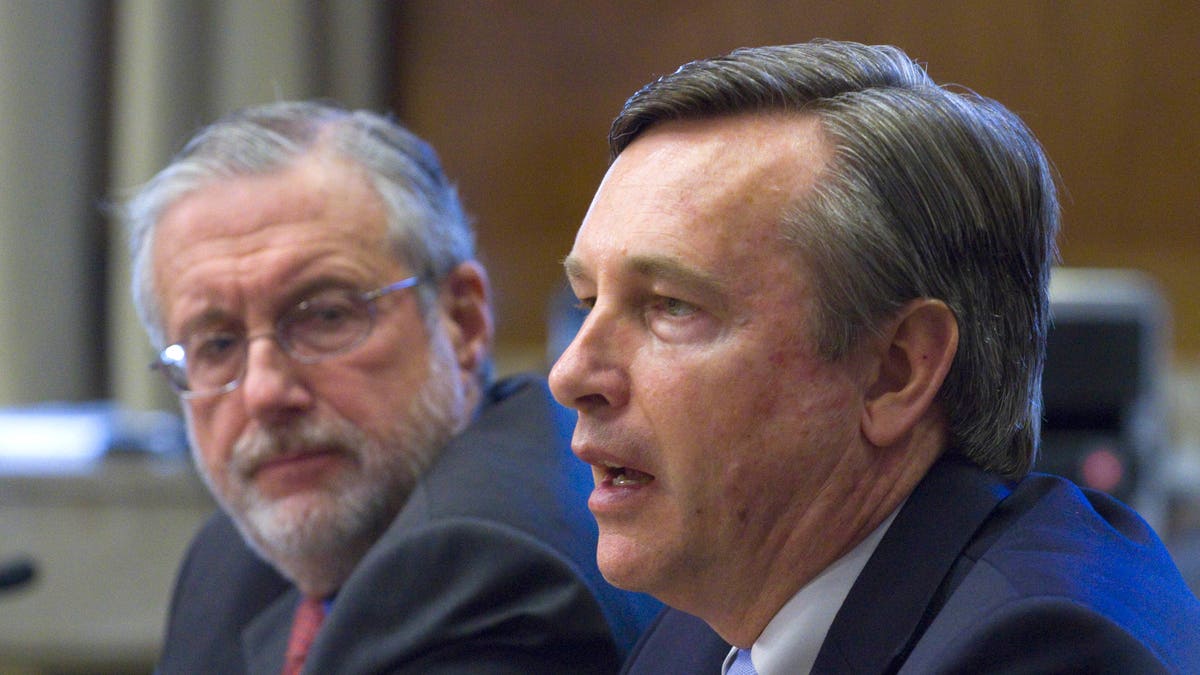
Bill Borchardt, executive director for Operations, Nuclear Regulatory Commission (NRC), right, accompanied by Dr. Peter Lyons, acting assistant Energy Secretary for Nuclear Energy, testifies on Capitol Hill in Washington, Tuesday, March 29, 2011, before the Senate Energy and Natural Resources Committee hearing on Japan's nuclear disaster. (AP)
Government scientists testifying on Capitol Hill Tuesday say they've already thought of everything that's happened in Japan so far in developing safety designs at U.S. nuclear facilities, but are conducting new reviews to make sure the improbable doesn't become the possible.
At a Senate Energy and Natural Resources Committee hearing, scientists said they have placed upgrades on facilities, including "station blackout rules" that create a back-up system of power to keep coolers operational in case of an electrical failure; "inerting" containment chambers with nitrogen to prevent explosions and improved relief vents so that when pressure builds, limited amounts of radiation are released into the air.
The hearing came as President Obama prepared to deliver a speech Wednesday on his plans for the nation's energy security. Obama said in his State of the Union address that he wanted 80 percent of U.S. electricity to be generated by clean energy sources, including nuclear power, by 2035.
But that was before an earthquake-spawned tsunami crippled a nuclear plant in Japan, leaving that country grappling with its worst crisis since World War II. Tokyo Electric Power Co., the operator of the crippled plant, first lost electrical power and then the back-up generator after the one-two punch from Mother Nature on March 11. It didn't have enough battery power at its Fukushima Daiichi plant to keep the reactor core cool and avert a full-scale meltdown with neither electricity nor a back-up generator to prevent it.
"One lesson from Fukushima is the need to provide workers with options for dealing
with a station blackout lasting longer than the life of the on-site batteries," said David Lochbaum, a former plant engineer and nuclear safety director at the advocacy group Union of Concerned Scientists.
"In other words, the moment that any U.S. reactor enters a station blackout, response efforts should proceed along three parallel paths: (1) restoration of the electrical grid as soon as possible, (2) recovery of one or more emergency diesel generators as soon as possible, and (3) acquisition of additional batteries and/or temporary generators as soon as possible."
The NRC has already extensively reviewed and is approving future plant designs that will make sure an 8.9 magnitude earthquake like the one in Japan doesn't prevent long-term power sources from reaching the facilities.
Bill Borchardt, executive director for operations at the Nuclear Regulatory Commission, said the dislocation of any alternating current to power the coolers could be relieved by valve motions relying on stored air or off a D.C. battery power supply. Once the coolers are running, designs allow natural processes like gravity will create a water flow to keep the cores cool.
But under questioning, Borchardt acknowledged that none of the country's 104 nuclear plants have these design features in place now.
Borchardt said it's too soon to tell whether the Japan disaster revealed whether design changes are needed at existing plants. But he said any changes would be made without a license review process.
In the meantime, Borchardt said two reviews are coming -- an immediate 90-day review and then a six-month review.
The first will evaluate all the currently available information from the Japanese nuclear crisis to "identify immediate or near-term operational or regulatory issues potentially affecting any of the 104 operating reactors," he said.
The review will investigate the reactors' ability to protect against natural disasters, and respond to station blackouts and severe accidents, among other things, he said.
The second review will begin as soon at the NRC has sufficient information from the Japan crisis. That review will seek to identify additional potential research, generic issues, changes to the reactor oversight program and rulemakings.




